Once Upon a Time in Lead Generation
How Traditional Story Structure Can Aid Website and Advertising Performance

What’s the Backstory?
Most afternoons I take a walk in my neighborhood. Almost every afternoon I pass an old man, who smokes a cigarette alone in a chair on his deck. I feel for him, isolated like that. Maybe he’s a widower, I imagine, or never married. No children. No friends left nearby to visit. At least that’s what I think until an afternoon in June when I walk by and see the place packed like a parade route. People of all ages perched up on the deck or in chairs on the lawn. The old man stands with other men around a grill next to a table filled with food and snacks while folks help themselves to cold drinks from a nearby cooler and chat in groups while music from a nearby speaker pumps out summer hits.
He’s not alone. He was just alone when I saw him. The entire story about a lonely widower is something I constructed, based on the information I had.
Have you ever worn an old t-shirt because you thought it felt neglected? Maybe signed a greeting card from your dog? That’s more than just playful imagination. It’s storytelling, and our brains can’t help but do it.
Was I possibly projecting onto the old man during my daily stave-off-madness-20+-months-into-a-global-pandemic solo walks? Sure. But when we write a backstory for a passing stranger or anthropomorphize a household object, it’s about more than a drive to spin a tale. It’s about spotting patterns. Our brains are wired to look for recognizable patterns as a means of survival, and the traditional three act story arc, with a beginning, middle and end, is one of our favorites. It’s how we make sense of the world.
So, What Does This Mean For Your Website Program Page/Landing Page Copy?
We’re naturally conditioned to look for a narrative structure, to the point that our brains will try to construct it even when it’s not present (think me with the old man, or the birthday card from your pet). When a website program page or stand-alone landing page is driven solely by aesthetics, we typically see a non-linear approach to the copy, i.e. minimal chunks of content littered throughout a page. This layout forces your prospect to create the context for what they’re reading. That’s a pretty big ask for someone whose attention you might have for less than one minute.
Think of your favorite novel (is it Harry Potter? Crime and Punishment? No judgment, just curious). Now imagine that rather than reading the story as presented, you were given all the chapters individually, out of order. If you read them all, you would probably be able to piece together the narrative as intended, but it would be a lot of work and you would never have the experience of being immersed in the story. Also, would you bother?
When you have random blocks of content on your website program page or landing page, no matter how compelling a feature or how aesthetically pleasing it fits into the design, the experience for your reader is like getting chapters of a book out of order.
How to Organize Your Web/Landing Page Copy Using Narrative Structure
“Narrative” simply means a particular way to explain or present something. Below is a detailed breakdown of how to order the content of your webpage in a way that meets your reader where they are and actively leads them through the story you want to tell in order to decrease bounce and increase prospect engagement to drive leads.
Act I – Introduction: Set the Stage
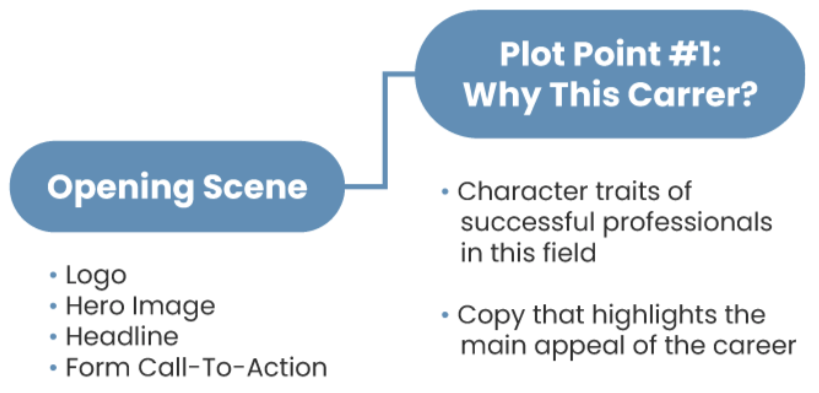
The first Act, the beginning of your story, is the set up. In a traditional story this is where you would establish the setting and introduce your characters. No different with your program/landing page. If your layout is working for you, your logo and branding should serve to set the scene and answer the question “where am I?”
That branding should be supported by the opening paragraph. This really is the introduction to your story, the “once upon a time…”. This copy is intended to help set the stage, to welcome readers in and to let them know what they can learn about on this page.
We know readership drops off in lower sections of online pages. There can be a temptation to load the top of your page with whatever you view as your highest value propositions, to jump right to your expert instructors, top-notch facilities or certifications. But if you don’t set the stage and invite the reader in, there’s no context for any of it and it becomes a point of friction.
In a good story, the first act also has an inciting incident. In the case of your web page, after we have established WHAT the page is about, you need to include a compelling detail that encourages the reader to continue on to the next section. This typically works best as a personal appeal. “If you’re looking for a creative career…” “If you enjoy helping others…” “If you’re interested in a hands-on trade…” that type of thing. Draw your reader in and let them know in what way the copy they’re about to read is specifically relevant to them.
Ultimately, the opening paragraphs of your website or landing page should do the following:
- Immediately establish where the reader is
- Introduce what the reader can learn about on the page
- Set up WHY that information is relevant for the reader
Act II – Rising Action: Outline the Career
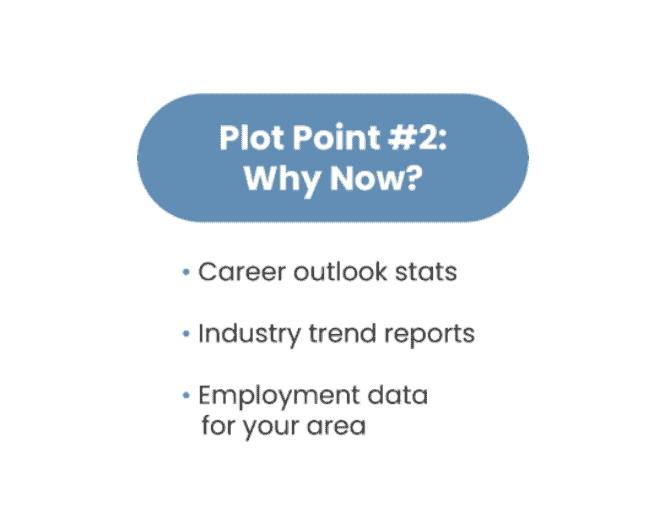
In a classic story, Act II is where we see the bulk of our plot points. On a program/landing page, these are the sections after the introductory paragraph where you get into the details of the career outcome plus program benefits.
This is where you want to include valuable information such as:
- Career Outlook
- Industry Trends
- Employment Data for Your Area
- Benefits of the Career such as “Opportunity to Help Others” or “Flexible Schedules”
Act III – Climax: Why Your School?
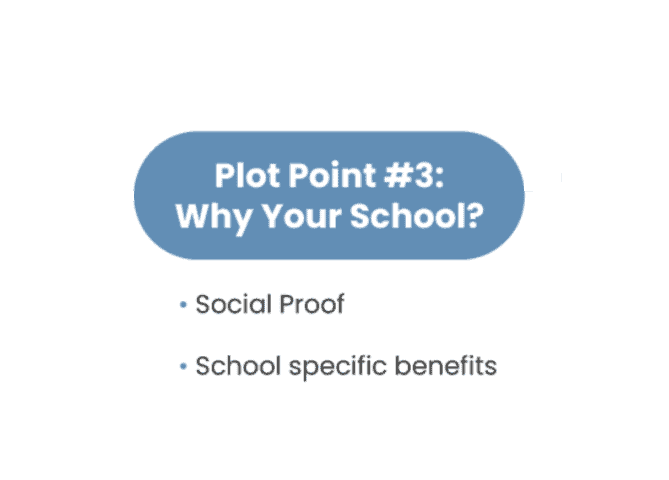 In a classic story arc, Act III is the most dramatic point of the story, where all of the events up to this point culminate. For your program/landing page, if you’ve ordered the information correctly, so far you will have explained the appeal of the career and what type of people find success and fulfillment in that field and you’ve alluded to your school as the path to that career. “Act III” of the page is where you drive home that your school is the solution for the reader interested in the career they’ve now read about.
In a classic story arc, Act III is the most dramatic point of the story, where all of the events up to this point culminate. For your program/landing page, if you’ve ordered the information correctly, so far you will have explained the appeal of the career and what type of people find success and fulfillment in that field and you’ve alluded to your school as the path to that career. “Act III” of the page is where you drive home that your school is the solution for the reader interested in the career they’ve now read about.
This is the section you can load up with all the incredible features and benefits of your school, all those things that make your offering unique and compelling. This section is also an excellent place to incorporate “social proof,” testimonials from happy successful graduates, employers or any other relevant endorsements.
Information to include in this section:
- Social Proof/Testimonials
- Special Details About Your School/Offering
Denouement – Wrap It Up
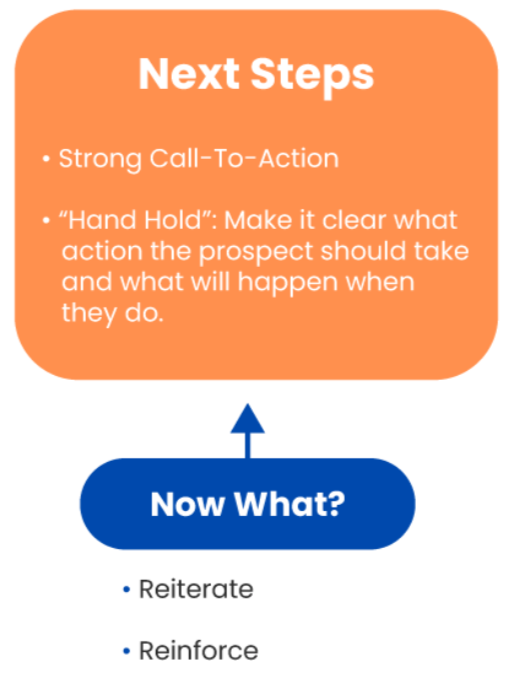 In a traditional narrative, the denouement is the part of the story where all the strands of the plot are drawn together and resolved, similar to the conclusion paragraph of an essay. This is the section where you reiterate the thesis statement of the page, “x program from ABC School is the optimal choice for this reader to get into y career in xy amount of time”, for example, and reinforce the main points of the page.
In a traditional narrative, the denouement is the part of the story where all the strands of the plot are drawn together and resolved, similar to the conclusion paragraph of an essay. This is the section where you reiterate the thesis statement of the page, “x program from ABC School is the optimal choice for this reader to get into y career in xy amount of time”, for example, and reinforce the main points of the page.
There should be no new information introduced at this point. Any career or program benefit should have been outlined earlier on the page.
The content of this section should:
- Reiterate
- Reinforce
The End – Happily Ever After!
Use clear and concise language in your call-to-action and spell out the benefit to the reader, in other words WHY they should reach out to your school.
This section should:
- Make it clear what action the reader should take – i.e. “fill out the form”
- Outline the benefit of taking that action – What’s in it for them?
Control the Narrative, Drive Engagement
pens next and not seem like standalone episodes.
When you structure your program/landing page content in a logical “start to finish” fashion, you control the narrative and take the burden off your prospect. This frees them up to absorb the message you want to get across and, ideally, make the choice to engage with your school.
Take a look through your website program and/or landing page copy and see whether your copy leads the reader through a clear beginning, middle and end. If not, can you reorganize the copy to fit that pattern? Control the narrative and you’ll drive higher engagement on your pages and ultimately increase lead conversion.
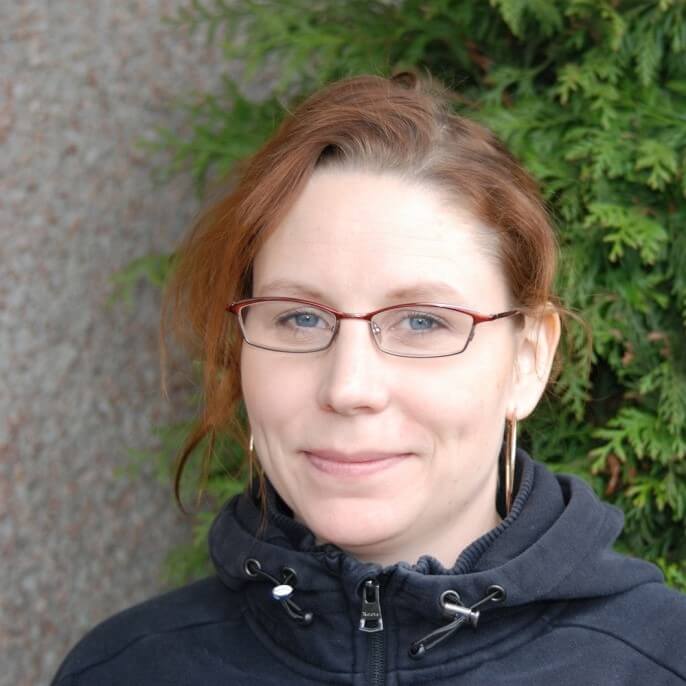
About the Author:
Katie Humphries is a Senior Copywriter for Enrollment Resources with decades of experience in EDU Marketing. Their work in testing and online conversion optimization contributes to Enrollment Resources’ culture of innovation, pursuit of truth and lead generation breakthroughs for clients and industry partners. Katie continues to enjoy a good walk.
You Deserve Better Than Just Leads – Start writing your school’s story! Get unprecedented insight into your prospective students — their motivations, goals and personality —and help your Admissions teams convert more prospects into enrolled students with Virtual Adviser. Learn More
